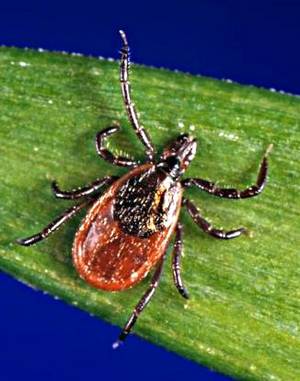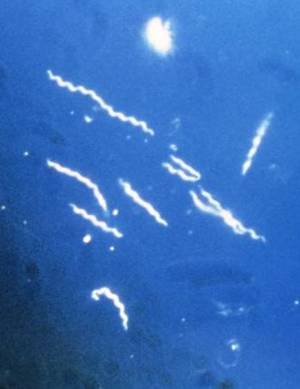The Deer Tick

The Deer Tick, also known as the Black-legged Tick and the Lyme Disease Tick (as well as Ixodes scapularis or Ixodes dammini), is widely distributed in the eastern and central US states.
It is found in at least 35 states, from Maine south to Florida, west into central Texas and then north to Minnesota. Its need for high humidity stops it spreading to desert areas and high mountains. It is mainly found in woodland forests and adjacent brush or grass. The distribution of the Deer Tick is linked to the habitat of its primary reproductive host, the white-tailed deer (Odocoileus virginianus), although it has been found on at least 125 different species of hosts.
These parasites start life as an egg, which hatches to produce a six-legged larvae. This feeds and molts to an eight-legged nymph, which in turn feeds and molts to an eight-legged adult. Larvae are the size of a pin head, while adults reach about ? th of an inch in length.
The Deer Tick is a three-host tick, which means it infests and feeds on three different hosts during its life. Like other species of tick, the larval and nymph stages prefer smaller mammals and birds while the adult stages prefer not only deer but also dogs, horses or even humans.
A human or dog can be bitten by the Deer Tick any stage of its development. It locates a host by "questing", which involves climbing onto grass tips or leaves where it sits with its front legs extended, waiting for a host to brush past and "ambushing" the host, clinging on.
|
"[Deer Tick] nymphs, which will bite humans aggressively, are the main stage responsible for the transmission
of disease to humans."
|
The majority of larvae emerge from eggs in late spring and their peak period of activity is in the summer, predominantly August and September. There is also a smaller peak in May, as adults vary somewhat in their time of breeding.
After feeding, the larvae drop off the host, usually into leaf litter, then hibernate over winter or molt directly to nymphs depending on the temperature. Nymphs also feed during the summer, from May through July in northern regions and January through September in the southern US. Nymphs, which will bite humans aggressively, are the main stage responsible for the transmission of disease to humans.
Nymphs molt to adults in the fall. The adults seem to have two main breeding periods. Although they are most abundant in the fall, from October through December, those which do not find a host hibernate over winter, then quest again the next spring, typically from March to May. Once adults have attached to a host, they mate, then engorge on blood. The engorged females drop off the host and lay up to 3000 eggs in the soil and leaf litter. These hatch up to a month later. The life cycle of the Deer Tick ranges from two to four years, with two being more common.
|
Anti-tick treatments
|
Pet Shed's most popular solutions for ridding your pet of ticks
|
The Deer tick is the carrier of Lyme Disease (Borrelia burgdorferi) in the central, upper Midwest and northeast US (In the west, a closely related tick, I. pacificus, is the carrier of Lyme Disease, and in parts of the Rocky Mountains, another, I. neotomae, can also transmit this disease).
Transmission via saliva requires 24 hours of attachment to a host, which is why it is so important to check pets daily and remove any ticks as soon as possible. Remember that this disease can affect both humans and pets, causing symptoms such as fever, arthritis, lethargy and a loss of appetite.
Lyme Disease is well maintained in the Deer Tick population. Within a single calendar year, the nymph numbers peak prior to the larval numbers. This means that any diseases the nymphs are carrying are transmitted to hosts (primarily the white-footed mouse) when they feed.

The next larval generation feeds on the same hosts later in the summer and can pick up the infection transmitted to the host by the previous nymph generation. The newly infected larvae then have the disease when they molt to nymphs and adults and can infect new hosts, including dogs and humans.
This makes the Deer Tick an excellent carrier of Lyme Disease, as there is a constant reservoir infection cycle maintained between the parasites and the mice which ensures the disease is passed from generation to generation.
The Deer Tick is also the vector of Human Granulocytic Ehrlichiosis or HGE (Anaplasma phagocytophilum) and Human Babesiosis (Babesia microti). It may also cause tick paralysis in dogs.
The use of tick prevention products such as Frontline, collars or dips containing amitraz, or permethrin-based products is recommended throughout the tick season in conjunction with daily inspections. Your veterinarian can recommend an appropriate product for your dog. Additionally, there are two vaccines available for dogs to prevent Lyme Disease. Your veterinarian may recommend the use of a vaccine, with annual boosters, if your dog resides in an endemic area.
If a pet is found to have a tick, it should be removed immediately. Do not touch the tick with your fingers,and ensure the tick is pulled out gently backwards, grasping the tick as closely as possible to the mouth parts to avoid leaving the head embedded in a pet's skin.
You may wish to keep the tick in a sealed jar to assist the veterinarian's diagnosis, in the event that your pet develops signs of tick-associated disease. If you do suspect a tick-related disease, take your pet to the veterinarian as soon as possible. The sooner treatment starts, the better the prognosis.
|
References
|
| Payne, P.A., Dryden, M.W., Carter, G.R. External Parasitic Diseases of Dogs and
Cats. In: A Concise Guide to Infectious and Parasitic Diseases of Dogs and Cats International
Veterinary Information Service, Ithaca NY. www.ivis.org What you should know about External Parasites. American Veterinary Medical Association. Schaumberg, IL. www.avma.org Tick Information Sheet: The Deer Tick. Veterinary Clinics of North America: Small Animal Practice. 21:1, pp 65,68; 1991. Merck Veterinary Manual. Merck & Co., Inc. Whitehouse Station, NJ, USA, 2006 The Blacklegged Tick (Deer Tick) Ixodes scapularis. Tick-borne Diseases Program. Monmouth County Mosquito Extermination Commission. http://www.visitmonmouth.com/mosquito/deertick.html The Role of the Deer Tick in Lyme Disease. Tick-borne Diseases Program. Monmouth County Mosquito Extermination Commission. http://www.visitmonmouth.com/mosquito/scaplyme.html Lyme Disease. Tick-borne Diseases Program. Monmouth County Mosquito Extermination Commission. http://www.visitmonmouth.com/mosquito/lyme.html |
Frontline� is a registered trademark of Merial